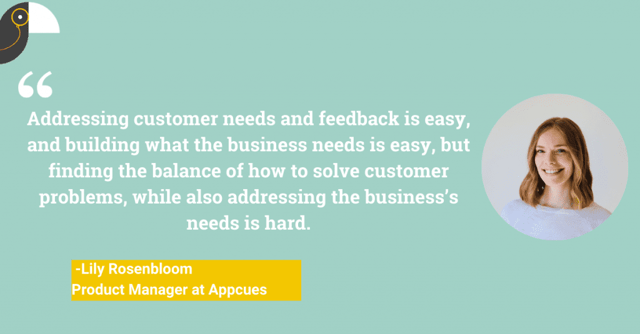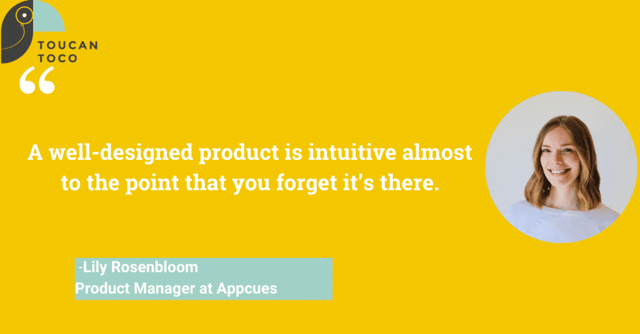1- Tell us a bit about yourself!
I’m Lily Rosenbloom, a Product Manager at Appcues, a no-code solution for delivering in-app experiences. With a background in customer experience and hospitality, I’m rooted in empathy, caring deeply about the people I work with and the experiences we deliver. When I am not wearing the multiple hats of a start-up PM, you can find me spending time with my rescue pup and husband, exploring New England’s hiking trails, or hosting a dinner party with family and friends.
2- In one word or one sentence, how would you describe your product management style?
My product management style is focused, collaborative, and customer-first.
3- How did you get into product management?
I started off in Customer Success, always championing the customer, their feedback and asking questions of our team. After being the loudest person in the room when it came to feedback, I was asked to join the product team to help solve the problems I raised.
4- What are one or two things you typically do during the first hour of your day that lead to a productive day?
Look at my calendar and the meetings I have for the day, upcoming days. I create a to-do list of things I need accomplished ahead of those meetings, and also block off times so I can go heads down on focused work in-between them.
5- What are some of the qualities of great product managers?
Good product managers are empathetic, always listen and ask questions, are great at getting to the root of the problem, and are comfortable living in the world of tradeoffs.
6- What has made you successful in your role?
I have been successful in my role because I have learned the delicate balance of meeting both the customer needs and business needs. Addressing customer needs and feedback is easy, and building what the business needs is easy, but finding the balance of how to solve customer problems, while also addressing the business’s needs is hard. And while I will never say I am perfect at this, because it’s hard, finding the balance of the two has helped me succeed in my role.
7-How can PMs stay ahead of user requirements or make sure they’re aware of them early?
Talk to your customers regularly. It’s something PMs always strive for, but it’s incredibly important not only to stay ahead of user requirements/pain points but also because it keeps you close to the person you are building for. Yes, we have personas, and roadmaps, and OKRs, but there is nothing like talking one on one with a customer to keep you in touch with who you are building for, and why you are building it.
8- How would you prioritize your resources when you have two important things to do but can’t do them both?
There are plenty of prioritization methods out there (just google it), but ultimately it comes down to impact (on your customers/business) and effort (to build it). I would look at how solving each pain point would impact our customers, what percentage of those customers, and how it could affect our business, then weigh that with the amount of effort it would take to solve that pain point.
9- How do you know if a product is well-designed?
A well-designed product is intuitive almost to the point that you forget it’s there. It’s frictionless, provides you will value in every use, and it delights you with small moments throughout.
10- What aspects of product management do you find the most exciting? The least?
For me, the most exciting aspects of product management are: Product Discovery and Delivery.
- Product Discovery: I love digging into a customer problem, brainstorming with our designer and then testing those assumptions. Better yet, I love being completely wrong in an assumption, because you learn so much in that process.
- Delivery: Ultimately what drives me as a PM is solving pain points for our customers, and there is no better feeling than hearing from a customer about the impact you’ve had after a release.
11- What is one best practice you’ve adopted/applied in the last few months that had a positive impact on your role? How has it helped you?
One thing I have adopted regularly in the last few months is: always ask ‘why.’ As a PM you’re asked questions daily; when will feature X ship? when will feature X be on the roadmap? Or why are we not prioritizing this feedback? As a former CSM, I always wanted to give an answer – especially because oftentimes I had one. However, I have learned that there is so much more to be learned by responding to these requests with ‘why.’ Maybe you will learn something new about a problem area that you hadn’t been privy to before. Maybe you will uncover the root of a pain point which might shift your thinking on it. And maybe you will make that requestor feel heard and acknowledged. Ultimately, it’s those small interactions that will help you build influence later down the road, and the small additional inputs you collect throughout that will shape your thinking and planning in the future.




